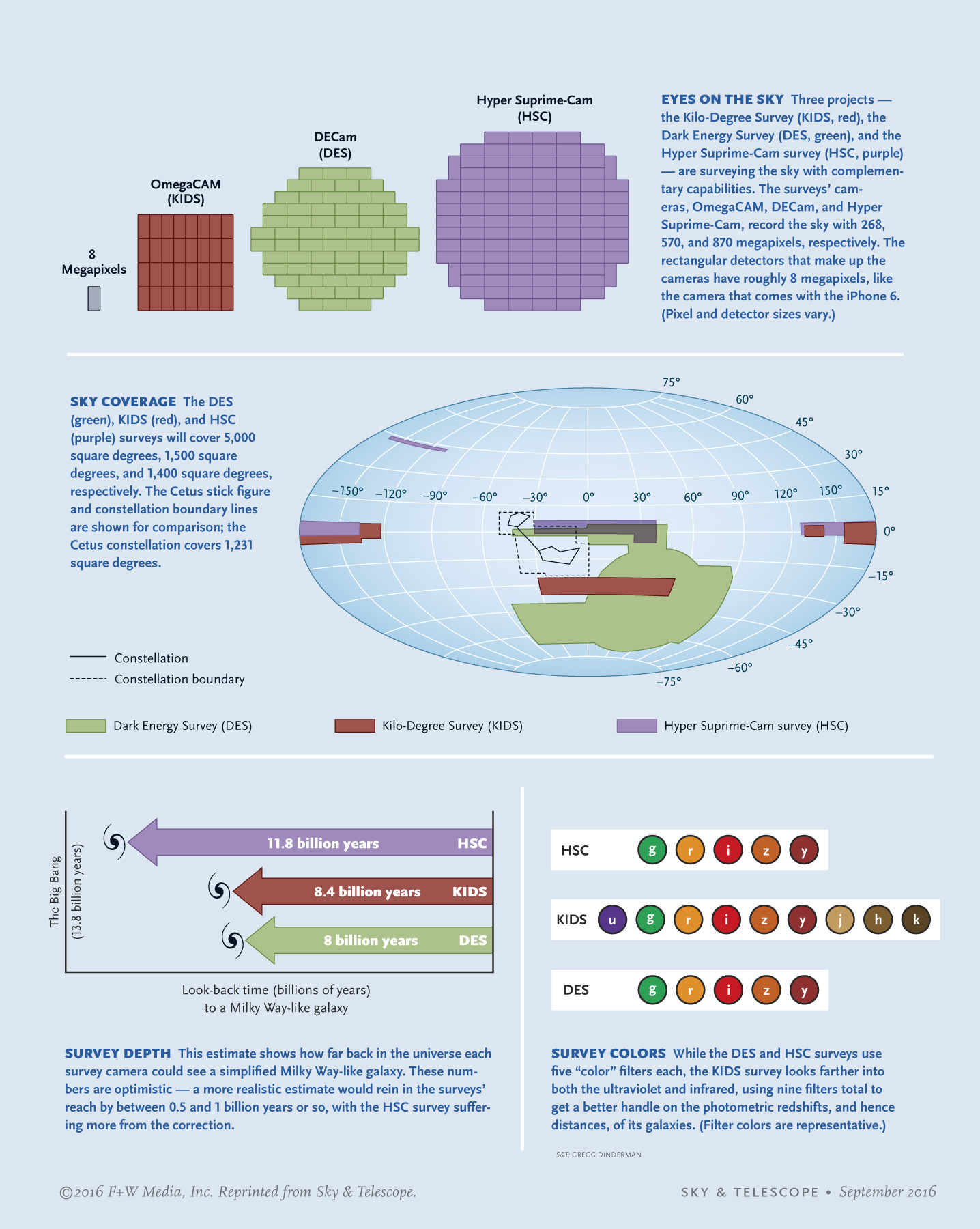Astronomy - Not-So-Clumpy Dark Matter Poses Cosmological Challenge
Astronomers analyzing a new sky survey have found that the distribution of dark matter in the modern universe is smoother than predicted from observations of a far younger universe.

Analysis of weak gravitational lensing produced this map of dark matter in a region surveyed by the Kilo-Degree Survey.
Kilo—Degree Survey Collaboration / H. Hildebrandt & B. Giblin / ESO
Kilo—Degree Survey Collaboration / H. Hildebrandt & B. Giblin / ESO
The large-scale distribution of dark matter in the universe is less clumpy than expected. That surprising conclusion is based on a thorough statistical analysis of the shapes of some 15 million remote galaxies.
Galaxy images are ever so slightly distorted by the gravity of intervening matter — a phenomenon known as weak gravitational lensing (see my article in Sky & Telescope’s September issue). But the international Kilo-Degree Survey (KIDS), which studies this so-called cosmic shear, finds an effect that’s about 10% smaller than predicted by the standard cosmological model.
“If the tension […] persists […], modification of the current concordance model will become necessary,” according to the KIDS team in an upcoming issue of Monthly Notices of the Royal Astronomical Society.
Mapping the (Dark) Cosmic Web
Current wisdom says that the newborn universe was pretty homogenous, as evidenced by the cosmic microwave background (CMB). The Big Bang’s afterglow shows only minute temperature variations across the sky, which means that density varied only minutely as well. But starting from these tiny fluctuations, dark matter clumped over time into a huge 3D cobweb of filaments and sheets. Gravity then drew in ordinary matter, which coalesced into superclusters, clusters, and individual galaxies.
Matter in the threads of this intergalactic cosmic web represents about 25% of all matter in the universe, according to Massimo Viola (Leiden Observatory, The Netherlands), who led the new study together with Hendrik Hildebrandt (Argelander Institute for Astronomy, Germany).
The only way to map this mostly dark cobweb is by studying the very subtle gravitational fingerprint it leaves on the shapes of background galaxies. KIDS, carried out with the European Southern Observatory’s 2.6-meter VLT Survey Telescope at Cerro Paranal in Chile, is one of three ongoing, large cosmic shear surveys. So far, it has mapped five areas totaling 450 square degrees (we’d need some 2,200 full moons to cover the same area on the sky).
The other two large cosmic shear surveys — the Dark Energy Survey (DES) at the 4-meter Blanco telescope at the Cerro Tololo Inter-American Observatory, also in Chile, and the Hyper Suprime-Cam (HSC) survey on the Japanese 8.2-meter Subaru telescope at Mauna Kea, Hawai‘i — haven’t published definitive results on this topic so far, though the DES did release analysis of preliminary "science verification" data that's roughly consistent with the KIDS result.
Based on observations by the European Space Agency’s Planck mission, cosmologists had expected dark matter to be fairly clumpy on the largest scales. Planck precisely mapped the CMB’s temperature fluctuations, then astronomers combined that information with what we know about the universe’s expansion history — along with some assumptions about the gravitational properties of dark matter — to yield a prediction of the current dark matter distribution. But the distribution KIDS found is smoother than predicted. The apparent discrepancy poses a challenge for astronomers to explain.

The Kilo-Degree Survey, Dark Energy Survey, and Hyper Suprime Cam are all tracing weak gravitational lensing to map the universe's dark matter. The KIDS result is only the first of what's to come. This graphic first appeared in the September 2016 issue of Sky & Telescope. (Click for larger image.)
Smooth Dark Matter Causes Tension
According to KIDS Principal Investigator Koen Kuijken (Leiden Observatory, The Netherlands), earlier cosmic shear observations by smaller and shallower survey programs already hinted at a smoother-than-expected dark matter distribution.
“Maybe the role of dark energy in the expansion history of the universe is different from what is generally assumed,” he says. “Or dark matter has different properties than popular cold dark matter models predict. It may even be the case that gravity behaves differently at the largest cosmic scales.” Kuijken is confident that theorists will soon come up with alternative models to explain the latest observations.
However, weak-lensing pioneer Tony Tyson (University of California, Davis), the chief scientist of the future Large Synoptic Survey Telescope (LSST) scheduled to see first light in 2022, says the disagreement between KIDS and Planck isn't all that worrisome.
"KIDS galaxies are much more nearby than those in deeper surveys," he says, "so the lensing signal is correspondingly smaller, making systematic errors more prominent." According to Tyson, solving the issue requires a deep and large-area survey of billions of galaxies over half the sky, with controlled systematics. "LSST is designed to address this."
No comments:
Post a Comment